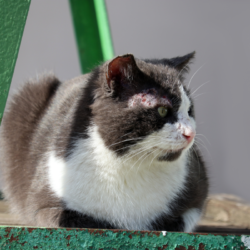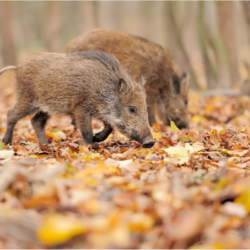Rabies is a serious and often fatal viral zoonosis, transmissible from animals to humans, which is a major public health problem in many parts of the world. Caused by the rabies virus, it mainly affects mammals, including dogs, bats and humans. The virus attacks the central nervous system, causing severe neurological symptoms. These symptoms generally lead to death if treatment is not administered quickly after exposure.
What virus is involved?
Rabies is a serious viral encephalitis affecting only mammals. The rabies virus belongs to the Rhabdoviridae family and the Lyssavirus genus. It mainly infects vertebrates, with humans being an accidental host.
This Rhabdovirus has a non-segmented, negative-sense, single-stranded RNA genome, lacking a polyA cap and tail, and measuring around 12 kilobases. The genome consists of five genes: N (nucleoprotein), P (phosphoprotein), M (matrix protein), G (glycoprotein), and L (large protein, RNA-dependent RNA polymerase).
The rabies virus is fragile, sensitive to temperatures above 50°C, ultraviolet rays, light, soapy solutions and lipid solvents (ether, chloroform). The virus targets the brain, particularly the limbic system, without destroying the cells in which it multiplies.
Attachment involves molecules such as gangliosides, phospholipids, sugars and glycoproteins, as well as various receptors (nicotinic, NCAM, glutamate metabotropic, NGF). Penetration is by endocytosis, followed by release of the nucleocapsid into the cytoplasm after membrane fusion.
During the eclipse phase, viral synthesis is activated. The L protein has four enzymatic sites: RNA-dependent polymerase, methylase, poly A polymerase and protein kinase. Transcription and replication depend on the concentration of N protein.
The assembly and release of virions occurs by budding of cell membranes, with the G protein directing the assembly of spicules and the M protein condensing nucleocapsids.
The main reservoir of the virus appears to be certain bats. The reservoir-vectors are wild and domestic carnivores. After a bite, the virus multiplies in muscle tissue, migrates via synapses to the central nervous system and spreads throughout the body, leading to encephalitis and behavioural disorders.
Death results from destruction of the brain areas controlling automatic breathing.
How does the disease manifest itself in animals?
Terrestrial mammals, including bats, can be infected with rabies. The geographical distribution and frequency of cases vary: in Europe, mainly foxes; in Africa and Asia, mainly dogs and cats; in Central and South America, vampires (bats), as well as dogs.
Rabies is usually transmitted by bite and saliva a few days before symptoms appear and throughout the course of the disease. Transmission by objects soiled with infected saliva is rarer.
Symptoms appear after damage to the brain: an asymptomatic period lasting several months, followed by changes in behaviour and nervous disorders (paralysis), leading to death within a few days. In domestic animals, there is a tendency to bite or, on the contrary, apathy. Wild animals show unusual behaviour, moving around in broad daylight and allowing themselves to be approached.
The rabies virus circulates in wild carnivores (wolves, foxes, jackals, coyotes), responsible for sylvatic rabies. Domestic dogs and cats contract rabies, causing urban rabies. Bats in America and Europe also contract the disease, but their epidemiological role remains limited. In Latin America, haematophagous bats play a significant role, where rabies kills 30-40% of unvaccinated cattle.
In dogs, rabies develops in three phases: behavioural changes, excitation with hyperaesthesia and convulsions, followed by a paralytic phase with hypersalivation, depression and coma. Herbivores such as cattle, sheep and goats can also present furious forms of rabies.
Rabies is rarely cured, with the exception of certain bats. Veterinary sur geons systematically try to rule out rabies when a dog shows nervous disorders.
How is rabies transmitted?
Rabies is transmitted mainly by biting, and more rarely by scratching or licking, by a rabid animal. Although no indigenous cases have been reported in recent decades, there have been a few imported cases. Occupational activities at risk include contact with potentially rabid animals (bats, illegally imported animals), travelling to countries where rabies is still present, and working in rabies diagnostic laboratories. Humans are accidental and terminal hosts, with virtually no human-to-human transmission. Almost all human cases (nearly 98%) are the result of rabid dog bites.
Rabid cat bites are particularly serious, as they are often multiple and highly penetrating. Attacks by rabid wolves are dangerous because of their size and ability to inflict multiple bites. Transmission by domestic herbivores is rare but potentially dangerous. In South Africa, one case of a bite from a rabid horse has been reported. Bat transmission is exceptional in Europe, with only 4 human cases between 1977 and 2012. In French Guiana, one case occurred in 2008.
No cases of human rabies caused by rodent bites, ingestion of raw meat or raw milk from a rabid animal have been reported anywhere in the world. Although human-to-human transmission is theoretically possible, it is extremely rare, particularly in the case of corneal transplants. The virus does not penetrate healthy skin. Handling dead animals can also be contaminating, as the virus remains virulent in the cadaver for some time. There are currently 17 species of rabies virus, differentiated by their geographical distribution and main hosts. Classical carnivore rabies is mainly linked to the RABV virus.
What are the symptoms in humans?
After inoculation, the rabies virus begins to multiply at the point of entry into muscle tissue without causing any visible damage. It then penetrates the nerve endings of peripheral neurons and travels to the cell bodies by retrograde transport, multiplying along the way. When it reaches the brain, it actively replicates, causing behavioural disorders and aggression due to damage to the limbic system. The virus remains beyond the reach of the immune system, which is very problematic. It then spreads to various organs and tissues, such as the salivary glands and eyes.
The incubation period varies from a few days to several years, with an average of 1 to 3 months. The incubation period may vary according to the infectious dose, the place of inoculation and its richness in nerve endings. Initial signs include pain and local reactions at the site of inoculation, followed by neurological signs of anxiety, confusion and agitation, progressing to furious encephalitis (70-90% of cases) or paralytic encephalitis (10-30% of cases).
The furious form manifests as hydrophobia (spasm when swallowing liquids), aerophobia (facial spasm triggered by a breath of air) and photophobia. Symptoms include hallucinations, delirium, convulsions and fever, culminating in death from cardio-respiratory arrest within a few days.
The paralytic form, resembling Guillain-Barré syndrome, progresses more slowly, without hydrophobia, but is almost always fatal, with destruction of the brain areas controlling breathing.
Once symptoms appear, the disease inevitably leads to coma and death within a few days. Human rabies is fatal in 100% of cases once declared, with death occurring within 4 to 6 days.
How is it diagnosed?
The diagnosis of rabies is based on the search for viral RNA in a skin biopsy from the nape of the neck or by various techniques detecting all or part of the virus in infected tissues (skin, urine, saliva) before or after death. The presence of anti-rabies antibodies is inconsistent and delayed. Their measurement by immunofluorescence in post-mortem brain tissue is the reference method for confirmation. Saliva samples are also analysed. In addition, a lumbar puncture is performed to obtain cerebrospinal fluid. This is then examined.
In France, diagnosis in animals is based on detection of the viral antigen and isolation of the virus from brain tissue. Doctors suspect rabies when symptoms such as headache, confusion and other signs appear, especially after an animal bite or exposure to bats. However, many rabies patients are unaware that they have been bitten or exposed.
The PCR (polymerase chain reaction) technique multiplies copies of a gene. It is commonly used to identify the unique sequence of viral DNA in a sample of skin, cerebrospinal fluid or saliva. Several samples taken at different times increase the chances of detecting the virus.
Current diagnostic tools cannot detect rabies before the clinical phase. In the absence of specific signs such as hydrophobia or aerophobia, or a history of contact with a suspect or confirmed animal, clinical diagnosis is difficult. Confirmation of human rabies, both ante mortem and post mortem, uses a variety of techniques to detect the virus, viral antigens or nucleic acids in infected tissues (brain, skin, saliva).
Is there a treatment for rabies?
This is a preventive treatment using an attenuated cell-grown vaccine, administered after infection to stimulate the immune system and create protection before the virus reaches the brain. Anti-rabies immunoglobulin of equine or bovine origin can be administered as a supplement. Post-exposure prophylaxis (PEP), or curative rabies treatment, should be administered immediately after a high-risk wound or bite.
Rabies is characterised by its long incubation period, which means it can be prevented by vaccination even after exposure. PPE is a race against time between the spread of the virus and the immune response. It aims to accelerate the production of neutralising antibodies by vaccination (active immunisation) and, depending on the case, by the administration of specific immunoglobulins (passive immunisation). According to the WHO, rapid PEP is 100% effective, even in cases of severe exposure. Failures are often attributed to late treatment, poor wound care or incomplete treatment.
Local treatment consists of eliminating the pathogens at the point of infection by mechanical means (washing) and chemical means (antisepsis). The wound should be washed thoroughly with soapy water, rinsed with clean water and disinfected with an antiseptic. Large wounds require emergency treatment. This includes surgical exploration and repair, antibiotic therapy and tetanus prevention. Post-exposure treatment includes several injections of vaccine and, if necessary, immunoglobulins.
In France, inactivated vaccines are produced on cell cultures (Vero cells or chicken embryo) using different intramuscular injection protocols. The intradermal route is also effective, reducing costs and the doses required.
Treatment for overt rabies is almost always fatal. Care is palliative, focusing on hydration, tranquillisers and sedatives, avoiding invasive care. The Milwaukee protocol has resulted in some survivals. However, it is no longer recommended because of its low success rate and serious after-effects.
What are the means of prevention?
Rabies is a contagious animal disease and a notifiable human disease. It is also recognised as a compensable occupational disease (Table 30 in the agricultural scheme and Table 56 in the general scheme), requiring a declaration to be made by the worker or his heirs. The rabies virus is classified in hazard group 3 (R. 231-61-1 of the French Labour Code).
It is advisable to avoid all contact with unknown animals, especially in countries where rabies is endemic. A preventive rabies vaccine is recommended in France for travellers, professionals and chiropterists at risk of exposure. The vaccine is administered to people whose activities present a risk of infection.
Preventive vaccination uses the same vaccines as curative vaccination. In France, the 3rd generation human vaccines available are prepared on cell cultures: the Pasteur rabies vaccine (PVRV) and the Rabipur vaccine (PCECV). The protocol recommended by the WHO consists of three injections on days 0, 7 and 28. Boosters are given according to serological monitoring, every 2 years in low-risk situations and every 6 months in high-risk situations. This preventive vaccine does not dispense with curative vaccination in the event of a bite.
Adverse reactions to cell culture vaccines include minor pain and inflammation in 35% to 45% of those vaccinated, and mild reactions such as fever, headache and digestive problems in 5% to 15% of subjects.
The best way to prevent rabies is to avoid being bitten by animals, particularly wild animals. It is advisable to stay away from unfamiliar pets and wild animals, and to call the local health authorities if an animal appears to be ill.
International control
International trade in domestic and wild animals is subject to strict regulations, including the presentation of a validated international veterinary certificate. Each country must bring its rules for importing live animals into line with OIE standards. Epizootics of wild terrestrial rabies are treated by vaccination. Reduction of wild populations is not recommended.
Mass vaccination campaigns mainly target dogs, with a minimum vaccination coverage of 70%. This strategy has proved effective in stopping transmission between dogs and reducing transmission to humans and other mammals. Vaccination should be accompanied by control of stray dogs, but not by culling, which is ineffective in the long term.
Oral vaccination of foxes using baits, first tried out in Switzerland in 1978, was adopted in France in 1986, with bait drops by helicopter in 1988. This method reduced fox rabies to negligible levels in 1998.
In the case of bat rabies, prevention is based on public education. In endemic areas, the use of mosquito nets to protect against bites is recommended. In Europe, bat rabies, which has been documented since 1954, is mainly caused by the EBLV-1 and EBLV-2 viruses. We advise against handling bats found on the ground in broad daylight.
The WHO, in collaboration with the FAO and WHOA, has launched the ” United against rabies ” forum to promote the fight against rabies. Gavi has included human rabies vaccines in its Vaccination Investment Strategy 2021-2025 to support the scale-up of PEP in eligible countries.
Anses, through its rabies and wildlife laboratory in Nancy, plays a key role in rabies surveillance and control. As a national reference laboratory and a European Union reference laboratory, it diagnoses rabies and issues vaccination certificates. The HCSP regularly updates the recommendations for post-exposure care in France.
Some epidemiological data…
According to the WHO, rabies causes around 59,000 deaths every year, mainly in rural areas of Africa and Asia. 40% of victims are children under the age of 15. This figure is probably underestimated, as the countries worst affected lack the means to diagnose the disease. The global cost of the disease is in excess of five billion euros a year, or even eight billion.
Rabies cannot be eradicated worldwide because it circulates in wildlife, but it can be eliminated locally. The WHO’s objective is to achieve zero deaths from human rabies by 2030. A country is considered rabies-free when no case of human or animal rabies transmitted by dogs has been confirmed for at least two years. The elimination process is divided into four phases: endemic, control, zero human deaths, and elimination. The situation remains fragile, requiring continuous monitoring.
In France
According to WHO and OIE criteria, France has been rabies-free since 2010, but the situation is under constant surveillance because of the risk of reintroduction.
In France, preventive vaccination of pets and people at risk (chiropterologists, vets) and a national surveillance plan have eradicated fox rabies (decree of 30 April 2001). Between 1968 and 2018, the authorities diagnosed 42 dogs and 3 cats with rabies, all imported. Imported cases, notably from Morocco in 2008, have led to legal proceedings and measures to treat those exposed.
The last case of cat rabies was in October 2013, and the last case of dog rabies was in May 2015 (a puppy returning from Algeria). France regained its status as a country free from terrestrial mammalian rabies in 2010, after losing it in 2008. A residual risk remains due to illegally imported animals, particularly dogs from Eastern Europe and North Africa.
In France, mandatory reporting and the National Reference Centre at the Pasteur Institute monitor human rabies. Between 1970 and 2018, the authorities diagnosed 23 cases of human rabies, including 22 imported cases, mainly from Africa. In 2008, a non-imported case emerged in French Guiana, probably from a bat. The last imported case, a 10-year-old child, died in 2017 after being bitten in Sri Lanka. In 2024, the authorities recorded three deaths due to rabies in French Guiana.
Between 1989 and 2014, experts identified 48 cases of rabid bats in France. The virus responsible for bat rabies differs from that of rabies in humans. Since 1924, no case of human rabies due to the classical rabies virus has been reported in mainland France, with the exception of imported cases.
In Europe
Terrestrial rabies is generally eliminated or controlled in the countries of the European Union. However, occasional cases of canine rabies persist in Eastern Europe. Rabies can cross borders, affecting populations of Vulpes vulpes foxes or via the transport of pets from endemic countries.
Finland and the Netherlands have been declared rabies-free since 1991.Germany eradicated its persistent outbreaks in 2008, notably in the state of Hesse, which had been a source of spread to other regions. Germany has undertaken oral vaccination campaigns for foxes. In 2008, Germany was declared rabies-free by the OIE.
Since 1998, Germany has detected 642 animals infected with rabies, including 44 domestic animals, 422 foxes and 115 bats. Since 2001, the authorities have confirmed eight cases of rabies in domestic animals. The disease has caused the death of five humans.
Belgium and Luxembourg declared the elimination of rabies in 2001. However, in May 2013, a bat carrying the virus bit a man in Luxembourg. Switzerland, which has been recognised as rabies-free since 1 January 1999, has reported a few isolated cases in bats and imported animals.
Italy eradicated rabies in 1997, but an epizootic originating in the Balkans broke out in 2011. Following a vaccination campaign, Italy once again achieved rabies-free status in 2013. In the Republic of Macedonia, the identification of cases of vulpine rabies in 2011 led to increased surveillance. The first Greek cases appeared in 2012 near the Macedonian border.
The Czech Republic, thanks to extensive fox vaccination campaigns, recorded its last case of rabies in 2002 and obtained rabies-free status in 2004. In Poland, massive fox vaccination campaigns have concentrated cases in the south-east, near the border with Ukraine. There were only around twenty cases in 2016.
In America
In Canada, rabies is a notifiable disease. Bats, arctic or red foxes, skunks, raccoons and domestic animals are generally responsible for infections.Ontario is the most affected province.
In the United States, canine rabies was declared eradicated in 2007. However, bats, skunks and raccoons remain the main vectors of infection.
The skunk rabies epidemic began in the north-east of the United States in the 1970s and spread to other states. Control by oral vaccination is more difficult than in Europe because of the diversity of vectors, the extent of the territories to be treated, and the higher costs of vaccination campaigns.
In Central and South America, canine rabies control campaigns have significantly reduced the number of human cases. In 2016, only 10 human cases of dog-transmitted rabies were reported in two countries: Haiti (8) and Guatemala (2). However, 23 human deaths due to rabies transmitted by animals other than dogs were recorded: Brazil (3), Colombia (2), Guatemala (1), Mexico (2), and Peru (15).
Surveillance and vaccination campaigns remain essential to control the spread of rabies in North and Latin America. Although canine rabies has been eradicated in the United States, vigilance is required due to the diversity of vectors. Efforts in Central and South America have shown positive results, but transmission by other animals remains a concern.
In the rest of the world
In Africa, the number of deaths from dog-transmitted rabies is estimated at more than 20,000 a year, or almost 36% of cases worldwide. In the Middle East, 229 deaths were recorded in 2015.
India is the worst affected country, accounting for almost 60% of the 35,000 annual deaths in Asia, or around 35% of cases worldwide. In Central Asia, there are almost 1,875 rabies deaths every year.
Since 2007, the Tibetan NGO Tibet Charity has been organising dog and cat vaccination campaigns in Dharamsala and neighbouring regions such as Chauntra, Gopalpur and Trilokpur. No cases of rabies were recorded in 2007.
The People’s Republic of China recorded a peak of 3,279 cases of human rabies in 2006. The southern and south-eastern provinces are the worst affected. Rabies ranks among the top three causes of death from notified infectious diseases, behind AIDS and tuberculosis. Since the 2010s, China has been reporting between 2,000 and less than 1,000 human cases a year.
The Republic of China (Taiwan) was rabies-free from 1961 to 2013, but the disease re-emerged in 2013 among Melogale.
Japan was endemic for rabies, with a peak in the 1920s, but the vaccination of dogs and the fight against stray dogs reduced the number of cases. In 1950, Japan passed a law to combat rabies, with the last cases recorded in 1954 and 1957. Since then, Japan has remained rabies-free, despite a few reported cases contracted abroad.
Australia, which is officially rabies-free, reported its first case in 1867. Two deaths occurred in 1987 and 1990, when the disease was contracted abroad. There are fears that the disease may have been introduced by animals from neighbouringIndonesia.
History of rabies
The primitive reservoir of the rabies virus appears to be certain bats, which can be healthy or diseased carriers depending on the species. A phylogenetic study suggests that the rabies virus evolved from insect rhabdoviruses around ten thousand years ago. The current rabies virus is thought to have passed from bats to carnivores between 900 and 1,500 years ago, although other passages may have occurred earlier.
The disease
Worldwide, the history of rabies outside Eurasia remains poorly documented. In Africa, there were sporadic cases in Ethiopia before the 20th century. Rabies did not exist in Australia and New Zealand before English colonisation from 1788, and the same is true of the Pacific islands.
In Europe
In Europe, the epidemiology of rabies before the 20th century is poorly documented. Reports mainly concern isolated cases or rare clusters of cases. In Franconia, an invasion of rabid wolves in 1271 killed 30 people. In Alsace, documents from the 13th to 17th centuries show bans on selling the flesh of animals bitten by wolves. Rabies appears to have spread throughout Western Europe from the 16th century onwards, probably as a result of population growth disrupting wildlife habitats.
The first cities to enact laws against stray dogs were Nancy in 1701 and Paris in 1725. A major epizootic of rabies occurred in 1719-1728, covering Hungary, Silesia,Germany and France. Great Britain was affected in 1734-1735. Rabies became common in London, France, Spain and Italy in 1759-1763.
In the 19th century, Vulpine rabies appeared in the Jura in 1803 and spread to Switzerland,Austria and Germany, persisting until the 1830s. In France, indigenous human rabies dates back to 1924, with the last case of canine rabies in 1958. France declared fox rabies eliminated in 2001 following vaccination campaigns in the 1990s.
In the New World
The origin of rabies in the New World is unclear. Bat rabies may have been present in pre-Columbian times. Arctic fox and wolf rabies are thought to have circulated from Siberia to Alaska thousands of years ago. Eskimo oral tradition suggests that rabies was known to them long before the arrival of Europeans.
The earliest European sources do not mention any cases of rabies in American wildlife. A Spanish publication in 1579 denied the existence of rabies in America. The first reports of cases of rabies date from the 18th century, in Mexico (1709), Cuba (1719), Virginia (1753), North Carolina (1762), New England (1768) and Peru (1803). This suggests that rabies in America, at least in temperate America, is a European import.
In the 19th century, rabies was widespread in North American wildlife, with skunk rabies reported in the Great Plains and California. In the 20th century, rabies in dogs declined thanks to vaccination and population control, drawing attention to rabies in other species, such as the raccoon in 1936 and the bat in 1953.
Human rabies became rare in developed countries in the 20th century. In the United States, there were 236 cases of human rabies between 1946 and 1965, and fewer than 2 cases a year in the 1990s. In Canada, there were 21 cases between 1924 and 1986. Human cases are much more numerous in Africa and Asia, with over 400 cases a year in Ethiopia and up to twenty thousand a year in India in the 1980s.
What we know about the disease
In Greek mythology, Lyssa is the demon or goddess of rage and furious madness. Aristotle mentions rabies in his History of Animals (VIII, 22), acknowledging the rabies of domestic animals and its effects on bitten animals. It was not until 1880 that the disease was understood. Pasteur improved on Galtier’s work, demonstrating that the central nervous system was the main site of rabies. In 1885, Pasteur succeeded in giving the first human rabies vaccination.
Description in Antiquity
Rabies is thought to have been known since at least 2000 BC. The first written trace appears in the Laws of Eshnunna in Mesopotamia (circa 1930), which required owners of rabid dogs to avoid bites, on pain of a fine in the event of the death of a third party.
In China, dog and human rabies are mentioned in texts dating from the 6th century BC. In the 4th century AD, the alchemist physician Ge Hong recommended bleeding the wound and applying moxibustion. In India, rabies and hydrophobia are described in the Sushruta Samhita. One of the remedies suggested in this Samhita is datura.
In Greek mythology, Lyssa is the demon or goddess of rabies. Dog rabies is depicted in the myth of Actaeon, who was devoured by his own dogs for having surprised Artemis in the bath. Aristotle mentions rabies in his History of Animals. He states that all bitten animals become rabid except man. This assertion was debated until the twentieth century.
Roman authors such as Dioscorides, Pliny, Galen and Celsus wrote about rabies. Celsus used the term ” virus ” to describe the cause of rabies, not in the modern sense, but as “poison” or “venom”. He recommended preventive treatments such as cauterisation and hot baths.
Byzantine authors passed on Greco-Roman knowledge, including various remedies. The Bible makes no mention of rabies. However, the Talmud does mention it. It is also described in detail by Maimonides. Islamic authors such as Avicenna developed a humoral theory of rabies.
Advances
In the medieval West, knowledge of rabies remained limited. The main saint interceding against rabies was Saint Hubert, whose relics cured rabies. The cult of Saint Hubert continued until the 19th century.
Access to Greek sources did not bring much progress. Girolamo Fracastoro proposed his theory of contagium vivum. He indicated that contagious diseases were transmitted by tiny germs or seeds. He advocated immediate cauterisation of the wound.
Three medical trends marked the beginning of the century: negative, neutral and positive. The positive trend was based on the work of Zinke, who demonstrated the existence of transmissible rabies. Pierre Victor Galtier showed that rabbits were a better model than dogs and proposed post-bite vaccination.
Louis Pasteur improved on Galtier’s work, achieving immunity in dogs and the first human vaccination in 1885. Pasteur’s method spread rapidly throughout the world.
The exact nature of the causative agent remained undetermined until 1903, when Adelchi Negri discovered Negri bodies, which were wrongly interpreted as a protozoan. In 1903, Paul Remlinger proved that the agent of rabies was a filtering virus. In 1913, Hideyo Noguchi succeeded in growing the first rabies virus in vitro. The exact nature of the rabies virus was gradually elucidated from the 1930s onwards using electron microscopy.
Vaccines
Pasteur designed the original vaccine using suspensions of rabbit spinal cord, attenuated by desiccation. Vaccination involved a dozen inoculations over ten days, with increasing virulence. Scientific and political figures such as Alfred Vulpian, Paul Brouardel and Henry Bouley supported this method. This facilitated its rapid adoption. However, Michel Peter and Auguste Lutaud criticised the approach, questioning Pasteur’s statistics and highlighting the associated risks, particularly neurological accidents caused by material that was still virulent.
Until the 1950s, rabies vaccines were produced using nerve tissue from rabbits, sheep or goats. Claudio Fermi and David Semple improved on Pasteur’s vaccine. The first was a live attenuated vaccine and the second a vaccine inactivated by phenol. However, these vaccines presented risks, in particular allergic encephalitis caused by the myelin present in the vaccines. In 1956, E. Fuenzalida developed an inactivated vaccine with reduced myelin content using mouse brain. Despite this, serious accidents still occurred, as in Fortaleza, Brazil, in 1960. The risk of these vaccines varied from 1 in 230 to 1 in 8000, depending on the vaccine.
Research into the production of rabies vaccines from cell cultures began in 1958 using hamster kidney cells. From the 1980s onwards, other culture media were used, including human diploid cells (HDCV), Vero cells (PVRV) and chicken embryo cells (PCECV). These vaccines are the most widely used in the world at the beginning of the 21st century. In 1982, in Thailand, the switch from Semple’s vaccine to HDCV reduced the rate of neurological complications from 1 in 155 to less than 1 in 50,000.





